
Rabbit house redesign to become a rabbit nursery
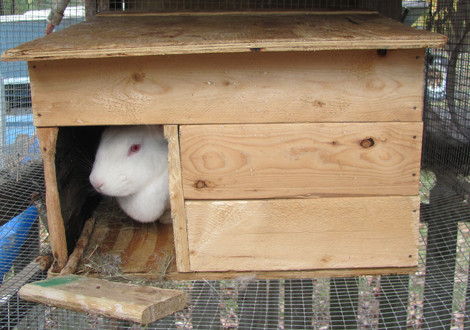 Since
we
decided to bring about our first litter of baby bunnies, one of the things on our
must-do list has been to rework our doe's house. We are in the
midst of some unplanned house remodeling at present, so I guess it's
only fitting that our rabbits get a remodel at the same time too.
At right, you can see our doe peeking out of what was her first
house. However, this house probably isn't ideal for caring for a
newborn litter of fuzzballs. So Dawn quickly went to work
modifying the original accommodations to better support our doe and her
future litter.
Since
we
decided to bring about our first litter of baby bunnies, one of the things on our
must-do list has been to rework our doe's house. We are in the
midst of some unplanned house remodeling at present, so I guess it's
only fitting that our rabbits get a remodel at the same time too.
At right, you can see our doe peeking out of what was her first
house. However, this house probably isn't ideal for caring for a
newborn litter of fuzzballs. So Dawn quickly went to work
modifying the original accommodations to better support our doe and her
future litter.
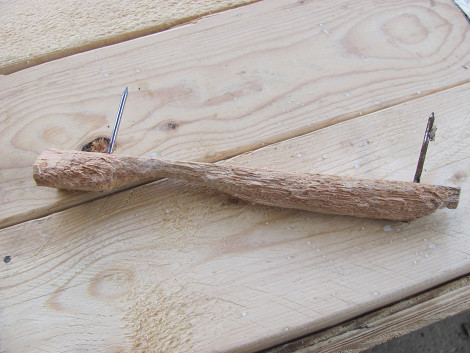 One thing we have learned about
our rabbits is that they will chew on nearly anything we give them,
especially wood. Ample supplies of things to chew on helps with
boredom, but it also helps keep their teeth in shape. With only
rabbit food to eat, their teeth can get to the point where they need
trimming. A generous supply of branches and pieces of
(untreated!) lumber helps to keep them from chewing on the hutch and
housing. As is evident from the photo, though, they will still
chew on whatever suits their fancy at the time.
One thing we have learned about
our rabbits is that they will chew on nearly anything we give them,
especially wood. Ample supplies of things to chew on helps with
boredom, but it also helps keep their teeth in shape. With only
rabbit food to eat, their teeth can get to the point where they need
trimming. A generous supply of branches and pieces of
(untreated!) lumber helps to keep them from chewing on the hutch and
housing. As is evident from the photo, though, they will still
chew on whatever suits their fancy at the time.
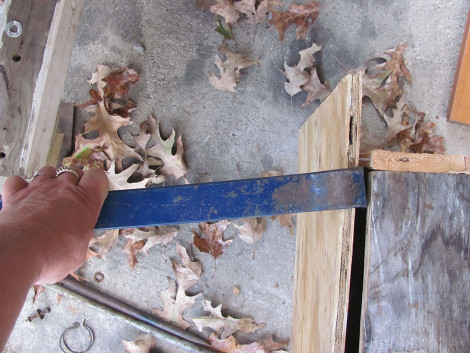 Dawn began reworking the house by
pulling it apart with what we call a "Wonder
Bar", an indispensable
tool for disassemblage of any carpentry work. She removed first
the roof, then front of the house. She planned to modify the door
so that it was on the upper portion such that there would be a
protective barrier on the bottom to prevent the newborn bunnies from
falling out of the house to certain doom. If they were to come
out of the house we'd feared that they would fall through to the ground
below or injure themselves on the wires of the hutch.
Dawn began reworking the house by
pulling it apart with what we call a "Wonder
Bar", an indispensable
tool for disassemblage of any carpentry work. She removed first
the roof, then front of the house. She planned to modify the door
so that it was on the upper portion such that there would be a
protective barrier on the bottom to prevent the newborn bunnies from
falling out of the house to certain doom. If they were to come
out of the house we'd feared that they would fall through to the ground
below or injure themselves on the wires of the hutch.
Dawn took the opportunity to
replace some of the more extensively chewed parts of the house like the
one in the second photo in this post. It's obvious how much these
bunnies like to chew on things when looking at this former piece of the
door frame.
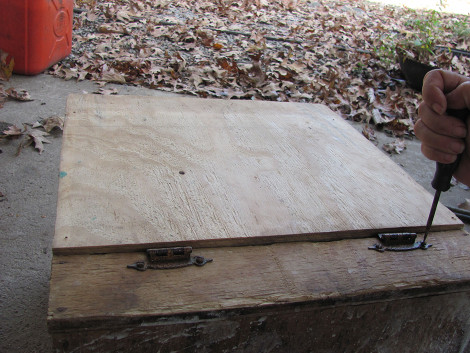 With the front of the house and
roof removed, she rotated the front 180 degrees and reattached
it. This provided the protective sill along the bottom.
Every bit as important as the protective sill is a hinged roof which
will allow us to check on the kits and replace soiled hay and
bedding. Dawn recycled some hinges off of an old cabinet door and
fitted them to the roof and house. This allows the easy access
needed.
With the front of the house and
roof removed, she rotated the front 180 degrees and reattached
it. This provided the protective sill along the bottom.
Every bit as important as the protective sill is a hinged roof which
will allow us to check on the kits and replace soiled hay and
bedding. Dawn recycled some hinges off of an old cabinet door and
fitted them to the roof and house. This allows the easy access
needed.
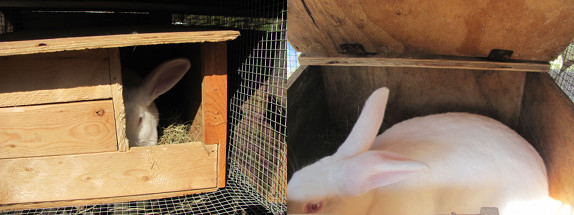
You can see the finished
product above. Our doe immediately took to the modifications when
the house was returned to the hutch and she had no issues hopping
inside through the modified doorway with its sill plate.
Hopefully the modifications Dawn made to her housing will provide a
trouble free home for the new kits expected in about two weeks or
so. I'm hoping that by the time of our next post we have some
news to report on that front.
Shannon and Dawn
will be sharing their experiences with raising meat rabbits on Tuesday
afternoons. They homestead on three acres in Louisiana when time off
from life and working as a sys admin permits.
Want more in-depth information? Browse through our books.
Or explore more posts by date or by subject.
About us: Anna Hess and Mark Hamilton spent over a decade living self-sufficiently in the mountains of Virginia before moving north to start over from scratch in the foothills of Ohio. They've experimented with permaculture, no-till gardening, trailersteading, home-based microbusinesses and much more, writing about their adventures in both blogs and books.
Want to be notified when new comments are posted on this page? Click on the RSS button after you add a comment to subscribe to the comment feed, or simply check the box beside "email replies to me" while writing your comment.
- Remove comment
